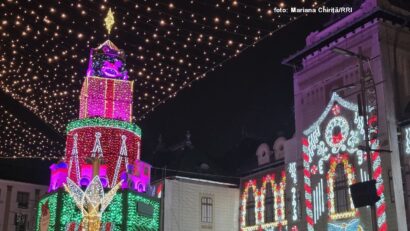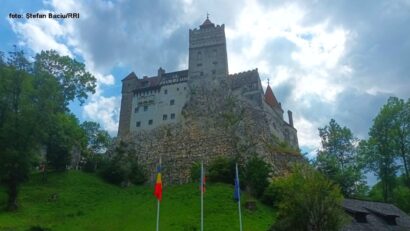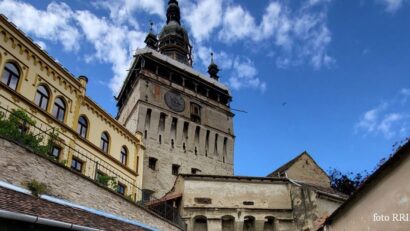Around Brasov County
Today we invite you on a trip to Brasov County, in central Romania

Daniel Onea, 01.11.2018, 12:53
Today we take you to Brasov County in central Romania. For mountain lovers, Brasov can be the starting point for various trips to the surrounding mountains such as Piatra Craiului, Postavaru, Piatra Mare and Bucegi. From the Tampa peak, on the outskirts of Brasov, visitors can get a wonderful view of the city and, on sunny days, they can see the entire depression. Several kilometers away from Brasov there lies the Poiana Brasov resort, an internationally-famed destination popular with those who practice winter sports. Actually, the entire area is full of tourist attractions.
Mihaela Damian is a travel agent with the Poiana Brasov Tourist Promotion and Information Centre, and next she will present to us the main attractions of Brasov:
“I recommend tourists to visit the Black Church in Piata Sfatului- Sfatului Square, since it is the best known building in the city. The Black Church is actually the biggest place of worship in Romania and one of the biggest medieval churches in Europe. The Black Church is famous for its collection of Oriental carpets on display inside the church and also for the mechanical organ, which is the biggest organ in Romania. Other places worth a visit in Brasov are the Museum of the First Romanian School and the Weavers Bastion, the pedestrian areas such as the alley at the foot of the Tampa mountain or the area called Behind the Walls where visitors will find the White and the Black Towers. Brasov is also host to many events popular with tourists. In November we organize the Etnovember Festival while during the winter holidays we have the event entitled Brasov, a fairytale city. Usually, on December 6, the authorities light the winter festive lights in Sfatului Square. The event Brasov, a fairytale city takes place during the entire winter holidays period. Tourists are invited to visit both the city of Brasov as well as Poiana Brasov resort. The resort is rich in leisure opportunities, and tourists can choose to either go on a trip to the mountains or participate in cultural activities.”
Another uniquely original asset which is part of Brasovs tourist offer is the Rope Street, known as the citys narrowest street, as it is only 1.3 meters wide. The Rope Street was built in the 15th century as an access way for firefighters it is also said to be the narrowest street in Europe. But what are other recommendations we could make to our tourists, especially to those who want to get familiar with the surroundings? Travel agent Mihaela Damian has a few suggestions:
“First of all, we could direct them to Poiana Brasov, where they can find leisure activities both during the warm and the cold season and where they can practice skiing, trekking or can just have relaxing walks through the mountain resort. Many hotels here have indoor swimming pools. From Poiana Brasov they can go straight to Rasnov Citadel, after which they can travel to Bran, where they can visit the famous castle there. “
The village of Harman, or Huntschprich in the Saxon dialect, meaning the “Mountain of Honey”, is a little and quiet village, lying in Central Romania, around 10 kilometers from Brasov. The most impressive asset here is the fortified church located in the center of the village, a real citadel, very well preserved, built in the 12th century. In the 15th century, the local community made an attempt to turn the Romanesque architectural style of the Evangelical church into a Gothic style, but the works did not go beyond the superposing of the bell tower, which was 32 meters tall, and would become the highest such tower in the Barsa Land.
Speaking about that, here is the custodian of the citadel, Dan Ilica-Popescu:
“Walking closer to the citadel, one can see the bell tower from afar. It is very important, because there are also four other smaller towers surrounding the main tower. That is something quite rare with village churches, since it was the sign that the village had the right to use death penalty. It is something you rarely see in small localities. The closer you get to the citadel, the clearer the image is, of the massive walls and the moat which in the beginning had surrounded the city. It was a defense method typical of the Middle Ages. The entrance is through a tunnel built after the year 1800. Initially, over the moat and replacing the tunnel was a drawbridge. One can enter the citadel through an oak gate, which has been preserved to this day. There used to be another three gates besides that.”
Once in Brasov County, one should not waste the opportunity to visit Feldioara fortress, for which refurbishment works have been completed this very year. The Romanian name of the place, Feldioara, is derived from Hungarian, as Föld-Vár means the earthen citadel. The German name of the citadel, Marienburg, meant the citadel of Mary, specifically referring to Virgin Mary, the patroness of the Knights of the Teutonic Order, who initially erected the fortress in 1211. Destroyed in 1241, the fortress was later rebuilt by the Saxon community in the region.
Georgiana Gamalie has preservation and curatorial expertise, and will next tell us a few things about Feldioara fortress:
“Feldioara Fortress has practically been reborn from ashes. After its restoration, which has been carried out in the past five years, today it has the shape it had in the 17th century, as archaeological findings and documents provided accurate information about that period. It is a place worth visiting, first of all because it is very beautiful. It has three towers that play host to exhibitions. We try to bring archeological evidence before the public: from bits of pots we found while excavating inside the fortress, including from the Neolithic, evidence of the fact that the area had been inhabited from times immemorial, to Dacian pots and also artifacts from the Middle Ages. But there are also items telling of habitation and cohabitation in Feldioara: one of the towers is hosting items donated or borrowed from the locals, by means of which we illustrate the crafts.”
Tourism information centers promote a 105-km route around Brasov. Along that route, you can visit 12 fortified citadels that are very special, among which Bran castle, the former residence of Queen Marie, which is one of Romanias most visited places.






























